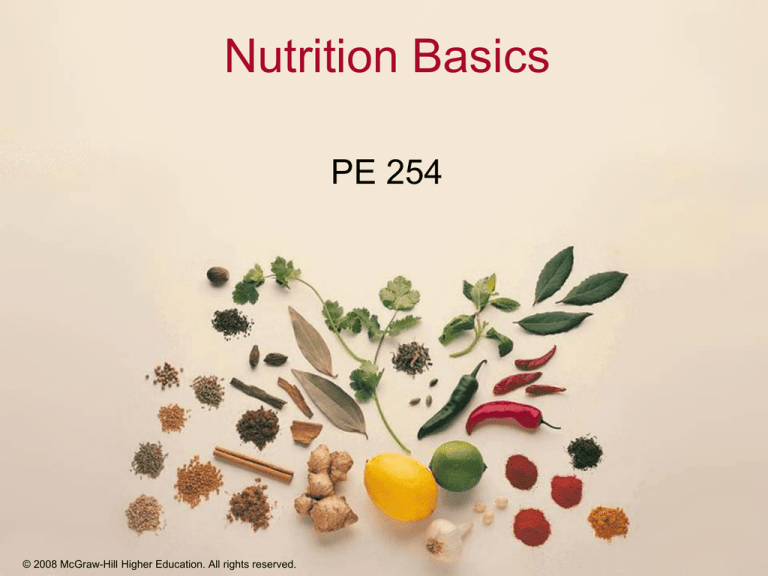
Nutrition Basics
PE 254
© 2008 McGraw-Hill Higher Education. All rights reserved.
Nutritional Requirements:
Components of A Healthy Diet
• 45 Essential nutrients
– Proteins, Fats, Carbohydrates, Vitamins,
Minerals and Water.
• Fuel Potential. Kilocalories (kcalorie).
• 1 Kcalorie = amount of heat it takes to raise the temperature
of 1 liter of fluid 1 degree of centigrade.
• 2000 kcalorie or calories per day meets a person needs.
• 3 supply energy
– Fat = 9 calories per gram
– Protein = 4 calories per gram
– Carbohydrates = 4 calories per gram
© 2008 McGraw-Hill Higher Education. All rights reserved.
Chapter 9
2
Proteins
• Forms muscle, bone, blood, enzymes,
hormones and cell membrane.
– Twenty common amino acids
• Nine essential amino acids.
• Eleven nonessential amino acids
– Complete proteins provide all essential
amino acids (e.g., meat, fish, poultry, eggs, milk,
cheese, and soy).
• Most plant proteins are incomplete (e.g., peas,
beans, and nuts).
– Recommended amount
• 0.8 gram per kilogram of body weight (0.36g
per pound)
• 10-35% of total calorie intake
– Average is 15-16%
© 2008 McGraw-Hill Higher Education. All rights reserved.
Chapter 9
3
Fats or Lipids
• Most concentrated source of energy
– stored energy and provides insulation and support
for body organs
– Two fats
• Linoleic acid (unsaturated fatty acid)
• Alpha-linoleic acid
– 10% from saturated fats
•
•
•
•
•
– Triglycerides - glycerol molecule with 3 fatty acids
Saturated Fat (solid at room temperature)
Mono-unsaturated
Poly-unsaturated
Hydrogenation (H+ + unsaturated fat)
Trans fatty acids
© 2008 McGraw-Hill Higher Education. All rights reserved.
Chapter 9
4
Fats and Health
• Cholesterol
*required for synthesis of cell membranes, vitamin D, and hormones
– High Density Lipo-Protein (HDLs) – good cholesterol; transport
cholesterol out of arteries
– Low Density Lipo-Protein (LDLs) – bad cholesterol; transport cholesterol
to organs and tissues, causing fat deposits on arterial walls
• Absorbs Fat-soluble vitamins (A,D,E & K)
– Make up 25%-35% of total daily calories
• 7% from saturated fat
• 10% from polyunsaturated fat
• 20% from monounsaturated fat
• Omega-3 fatty acids – AMDR -5-10%
• Omega-6 fatty acids – AMDR – 0.6-1.2%
• Recommended Intake
– Adults
• Men 17 grams per day of linoleic and 1.6 grams of alpha-linoleic
• Women 12 grams per day of linoleic and 1.1 grams of alpha-linoleic
– Only 3-4 teaspoons (15-20 grams) of vegetable oil per day
– AMDRs for total fat 20-35%
AMDR=Acceptable Macronutrient Distribution Ranges
© 2008 McGraw-Hill Higher Education. All rights reserved.
Chapter 9
5
© 2008 McGraw-Hill Higher Education. All rights reserved.
Chapter 9
6
Carbohydrates
• Supply energy for the body cells
• Two groups
– Simple Carbs: One or two sugar units
• Fruit, sugar, honey, malt (e.g., barley or wheat), and milk
– Complex Carbs: Multiple sugar units
• Starches and fiber
– Grains – wheat, rye, rice, oats, barley, and millet (white
grains)
– Legumes – dry beans, peas, and lentils
– Tubers – potatoes and yams
– Digestion
• Mouth and small intestines
• Break down to glucose
© 2008 McGraw-Hill Higher Education. All rights reserved.
Chapter 9
7
Refined Carbohydrates Versus
Unrefined (Whole) Grains
• All grains before processing
– Inner layer, germ
– Middle layer, endosperm
– Outer layer, bran
• During processing
– Germ and bran are removed leaving
just the starch of the endosperm
© 2008 McGraw-Hill Higher Education. All rights reserved.
Chapter 9
8
Glycemic Index and Glycemic
Response
• Insulin and glucose levels
• Quick rise in glucose and insulin
levels = high glycemic index
– Eating high glycemic index foods may
increase appetite
– May increase risk of diabetes and
heart disease
– Unrefined grains, fruits, vegetables
and legumes – relatively low glycemic
index
© 2008 McGraw-Hill Higher Education. All rights reserved.
Chapter 9
9
Recommended Carbohydrate
Intake
• Average American – 200-300 grams
• 130 grams needed to meet the body’s
requirements for essential
carbohydrates
• Adults – 45-65% of total daily calories
or 225-325 grams
© 2008 McGraw-Hill Higher Education. All rights reserved.
Chapter 9
10
Fiber – A Closer Look
• Food and Nutrition Board
– Dietary fiber nondigestible carbohydrate that is
present naturally
– Functional fiber nondigestible carbohydrate that has
been isolated or synthesized
– Total fiber is the sum of both
• Sources
– All plant substances
• Recommended intake
– 38 grams for adult men
– 25 grams for adult women
– Needs to come from foods not supplements
© 2008 McGraw-Hill Higher Education. All rights reserved.
Chapter 9
11
Vitamins
• Organic (carbon-containing) substances
required in small amounts to promote specific
chemical reactions (catalyst) within a living
cell.
• Thirteen vitamins:
– Four Fat Soluble: A, D, E, and K.
– Nine Water Soluble: C and 8 B-complex vitamins. Thiamin
(B1), Riboflavin (B2), Niacin (B3), Pyridoxine (B6), Folate, B12, Biotin and Pantothenic acid.
• Sources:
– Human body does not manufacture most vitamins
– Abundant in fruits, vegetables and grains
© 2008 McGraw-Hill Higher Education. All rights reserved.
Chapter 9
12
Minerals
• Inorganic compounds.
• Helps to regulate body functions, aid in
growth, maintenance of body tissues, and a
catalyst for energy release.
• 17 essential minerals.
– Major minerals - 100 milligrams or more.
• calcium, phosphorus (e.g., additives),
magnesium (e.g., nuts), sodium, potassium and
chloride (e.g., additives, such as sodium
chloride).
© 2008 McGraw-Hill Higher Education. All rights reserved.
Chapter 9
13
Water
• Composed of about 50-60% water
• Can live up to 50 days without food , but only
a few days without water
• Water and other beverages make-up 80-90%
of your daily water intake
• Men – 3.7 total liters of water, with 3.0 liters
(13 cups) coming from beverages
• Women – 2.7 total liters of water, with 2.2 (9
cups) coming from beverages
© 2008 McGraw-Hill Higher Education. All rights reserved.
Chapter 9
14
Other Substances in Food
Antioxidants –
– Reduction in cancers
– Vitamin C & E, selenium, carotenoids
• Phytochemicals
– Soy foods may help lower cholesterol levels
– Cruciferous vegetables render some
carcinogenic compounds harmless
– Allyl sulfides (garlic and onions) boosts the
cancer-fighting immune cells
© 2008 McGraw-Hill Higher Education. All rights reserved.
Chapter 9
15
USDA’s MyPyramid
© 2008 McGraw-Hill Higher Education. All rights reserved.
Chapter 9
16






